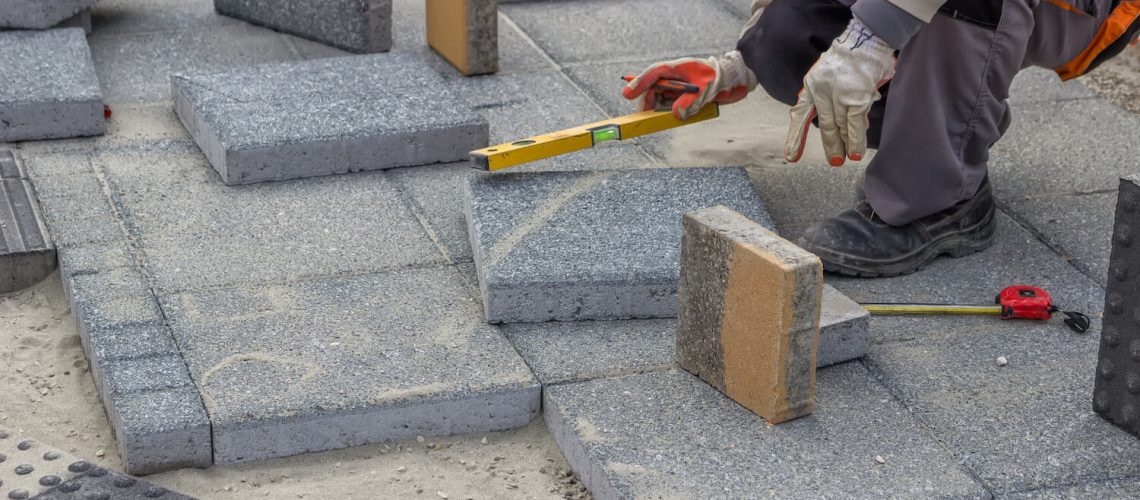Paver projects can transform your outdoor spaces, adding charm and functionality to your home. Whether you’re creating a stunning patio, a practical driveway, or a beautiful garden path, pavers offer versatility, durability, and aesthetic appeal. However, planning and executing a paver project is not without its challenges, and many homeowners often make common mistakes that can lead to costly errors and disappointment.
In this article, we will explore the most frequent mistakes to avoid when planning your paver project to ensure a successful and long-lasting outcome
Neglecting Proper Paver Planning
One of the most significant mistakes homeowners make when starting a paver project is rushing into it without thorough planning. Proper planning involves considering factors such as the purpose of the project, design, material selection, budget, and timeline. Failing to plan adequately can lead to costly changes and delays down the road.
Solution: Take the time to sketch out your project, measure the area accurately, and create a detailed plan. Consult with professionals if necessary, as their expertise can help you avoid costly mistakes and ensure a smooth execution.
Avoid Choosing the Wrong Paver Material
Selecting the right paver material is crucial to the success and longevity of your project. Different paver materials have distinct characteristics, including durability, color, texture, and maintenance requirements. Choosing the wrong material can result in pavers that deteriorate quickly or do not match your intended aesthetic.
Solution: Research different paver materials, consider your climate and the intended use of the space, and choose a material that suits your needs. Common paver materials include concrete, brick, natural stone, and clay pavers, each with its own set of advantages and drawbacks.
Ignoring Proper Drainage
Inadequate drainage is a common oversight when planning paver projects. Without proper drainage, water can accumulate, leading to erosion, settling, and even damage to your pavers. This can result in an uneven surface and costly repairs in the future.
Solution: Incorporate proper drainage solutions into your project. This may include installing a gravel base, using permeable pavers, or incorporating a slope to direct water away from the paved area. Consult with a professional if you’re unsure about the best drainage solution for your project.
Neglecting Proper Base Preparation
A stable and well-prepared base is essential for the longevity of your paver project. Some homeowners make the mistake of not adequately preparing the base, leading to settling, shifting, and uneven pavers.
Solution: Excavate the area to the appropriate depth and create a compacted, level base using materials like crushed stone or sand. Ensure the base is properly graded to prevent water from pooling.
Incorrect Paver Installation
Improper paver installation can lead to various problems, including uneven surfaces, loose or sunken pavers, and an overall unstable structure. This mistake is often the result of not following recommended installation guidelines.
Solution: Follow the manufacturer’s installation instructions closely, or consider hiring a professional paver installer. Proper techniques include using edge restraints, compacting the pavers, and ensuring consistent joint spacing.
Neglecting Paver Edge Restraints
Edge restraints are essential for keeping your pavers in place and preventing them from shifting over time. Some homeowners skip this step, thinking it’s unnecessary, but it’s a critical aspect of paver installation.
Solution: Install edge restraints such as plastic or metal paver restraints along the perimeter of your project. This will help maintain the integrity of your paver layout and prevent shifting.
Overlooking Weed Prevention
Weeds and grass can find their way through the gaps between pavers if proper weed prevention measures are not taken. Neglecting this aspect can result in a maintenance nightmare and an unsightly appearance.
Solution: Use a high-quality geotextile fabric or weed barrier beneath the base layer to prevent weed growth. Additionally, consider using polymeric sand in the joints between pavers, as it hardens when wet, preventing weed growth and stabilizing the pavers.
Inadequate Compaction
Properly compacting the base and the pavers themselves is crucial to ensure stability and prevent settling over time. Inadequate compaction can lead to an uneven surface and pavers that don’t interlock correctly.
Solution: Use a mechanical compactor or a hand tamper to compact the base and the pavers according to the manufacturer’s recommendations. Ensure that each paver is securely in place.
Neglecting Paver Maintenance
Paver projects, like any other part of your home, require regular maintenance to remain in good condition. Neglecting maintenance can lead to pavers that lose their color, become uneven, or suffer from weed growth.
Solution: Schedule routine maintenance tasks such as cleaning, resealing (if applicable), and repairing any damaged or sunken pavers. Proper maintenance will extend the life and appearance of your paver project.
Not Considering Expansion Joints
Expansion and contraction due to temperature fluctuations can cause pavers to shift and crack if expansion joints are not incorporated into the design. Some homeowners overlook this crucial aspect.
Solution: Include expansion joints, typically made of a flexible material like rubber or foam, at regular intervals in your paver layout. These joints will allow for movement without damaging the pavers.
Underestimating the Budget
Underestimating the budget is a common mistake in any construction project, including paver projects. Unexpected expenses can arise, and failing to account for them can lead to financial strain or an unfinished project.
Solution: Create a detailed budget that includes all project costs, including materials, labor (if hiring professionals), tools, and contingency funds for unexpected expenses. It’s better to be over-prepared financially than to run into financial problems during the project.
Skipping Permits and Regulations
In some areas, you may need permits or have to adhere to specific regulations when undertaking a paver project. Failing to check and follow these requirements can lead to legal issues and project delays.
Solution: Contact your local municipality or permitting authority to determine whether you need any permits or must adhere to specific regulations. Comply with all requirements to avoid potential problems down the line.
Rushing the Project
Impatience can lead to mistakes in your paver project. Rushing through the various stages of planning, preparation, and installation can result in errors that may not be immediately apparent but can cause problems later on.
Solution: Take your time throughout the entire project. Rushing can lead to costly mistakes, whereas a patient and thorough approach will ensure better results and satisfaction in the long run.
Overlooking Aesthetics
While functionality is important, neglecting the aesthetics of your paver project can lead to disappointment with the final result. Many homeowners focus solely on practicality and fail to consider the overall visual appeal.
Solution: Pay attention to the design and aesthetics of your project. Consider color, texture, pattern, and how the pavers will complement the surrounding landscape. A well-designed paver project can greatly enhance your outdoor space.
DIY vs. Professional Installation
Deciding whether to tackle the project yourself or hire a professional is a critical choice. Some homeowners underestimate the complexity of paver installation, while others may overestimate their DIY skills.
Solution: Assess your skills, experience, and the scope of the project realistically. If you’re uncertain about any aspect of the project, it’s often best to consult or hire a professional paver installer. Professional installation can ensure a higher level of quality and durability.
The Value of Professional Consultation
While many homeowners are eager to embark on a DIY paver project, it’s essential to recognize that some aspects of paver installation can be quite challenging, especially for those without prior experience.
Seeking professional consultation or hiring landscaping experts for your paver project can provide several natural advantages:
- Expertise: Professional paver installers have the knowledge and experience to handle various paver materials, designs, and installation techniques. They can offer valuable insights into what works best for your specific project and location.
- Time and Cost Efficiency: Although it may seem cost-effective to take on a paver project yourself, inexperienced DIY attempts can lead to costly mistakes. Professionals can streamline the process, potentially saving you both time and money in the long run.
- Access to Resources: Professionals often have access to specialized tools and materials that may not be readily available to the average homeowner. This can lead to a more efficient and higher-quality installation.
- Warranty and Quality Assurance: Many professional installers offer warranties on their work, providing peace of mind knowing that your project is backed by a guarantee of quality and durability.
Proper Maintenance for Longevity
Beyond the installation phase, maintaining your paver project is crucial for its long-term beauty and functionality. Regular upkeep can prevent issues like weed growth, fading, and uneven settling.
Here are some maintenance tips to keep your pavers looking their best:
- Cleaning: Sweep your pavers regularly to remove debris, dirt, and leaves. Occasionally, use a pressure washer or hose to remove stains and grime. Be cautious with pressure washing, as excessive pressure can damage the paver surface.
- Resealing: If your pavers were sealed during installation or have a sealer applied, monitor the condition of the sealant. Reapply it as needed to protect against stains and UV damage.
- Joint Refilling: Over time, the sand or polymeric sand in the joints between your pavers may erode. Replenish it as necessary to maintain stability and weed prevention.
- Weed Control: Keep an eye out for any weeds or grasses that may find their way through the gaps in your pavers. Promptly remove them and consider using a weed barrier beneath the base.
- Repairs: Address any damaged or sunken pavers promptly. Replacing or re-leveling them can prevent issues from spreading and affecting the entire project.
Conclusion
In conclusion, embarking on an outdoor paver project offers the opportunity to enhance your outdoor space significantly. However, it’s essential to approach the endeavor with careful planning, attention to detail, and a commitment to proper maintenance. Avoiding common mistakes, such as inadequate drainage, incorrect materials, and hasty execution, will lead to a more successful and enjoyable outcome. Whether you choose to tackle the project yourself or seek the assistance of professionals, remember that patience, diligence, and a focus on both function and aesthetics will ultimately result in a paver project that adds lasting beauty and value to your home.

